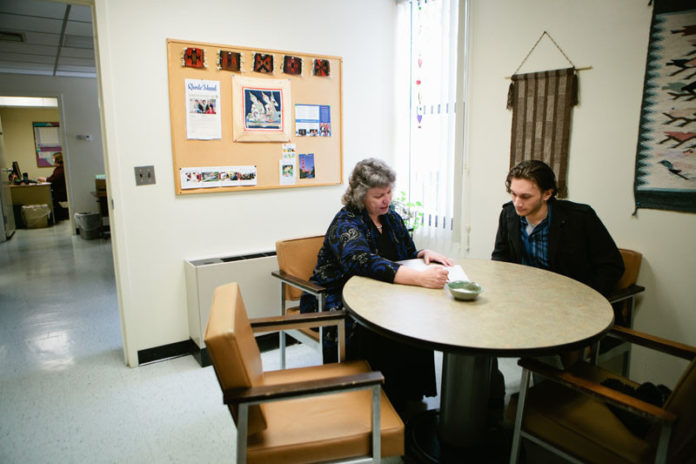
Goodbye Rolodex, hello linked list.
Career networking, apparently, has made the leap from cold calls and handshake introductions to online marketing via social media websites, especially for young professionals and those on the verge of their career and/or entering the workforce.
“LinkedIn, to me, is the best thing since sliced bread. If [our students] aren’t using it, we’re teaching them,” said Robbin Beauchamp, director of the career center at Roger Williams University in Bristol, who advises students on how best to conduct their job search. “Social media is huge. To me, it’s absolutely required.”
The National Association of Colleges and Employers Class of 2012 student survey reported more than 45 percent of students used social media in the job search, up from 41 percent in the association’s class of 2011 survey.
That number is up from just 7 percent of students who said the same when the association conducted its first such for the class of 2008.
“The reports certainly reveal the rise in use of social media to network,” said Kristen Johnson, regional vice president of the Creative Group and Robert Half Technology, a national staff firm. “Social media sites are really great tools. In this day and age, using all the available mediums of looking for a job is a smart way to be better positioned to land a job in a very competitive market.”
The 2012 survey revealed that 26 percent of students used social media sites such as LinkedIn, Twitter and Facebook to network or research employers and that 19 percent used it discuss job openings.
It’s not just job seekers taking to social-networking sites. Employers and recruiters also are delving into the sites as a means of advertising open positions beyond the now almost-antiquated job boards such as Monster.com and to scope out potential employees.
OnlineDegrees.com reports that 58 percent of recruiters used sites to source applicants and that companies expected to use social media to recruit for 80 percent of job openings last year.
Companies and recruiters, the site indicates, see social media sites as money savers and a way to target specific skill sets and job levels.
“We feel that [students] need to have an appropriate electronic presence in the same way that they have a print presence,” said Linda Kent-Davis, director of the career-development center at Rhode Island College. “We are actively encouraging a very deliberate, strategic way for students to utilize social media.”
That starts with choosing the correct sites to use in building their online brand.
Bullhorn Reach, a Boston-based, social-recruit software firm, released a study in February reporting that 48 percent of recruiters use LinkedIn exclusively, that 19 percent use LinkedIn and Twitter, and that Facebook is the least-effective social media site through which to post a job.
Kent-Davis, Beauchamp and Patti Goff, director of career education at Providence College, all advise using LinkedIn, a business-oriented site that allows users to showcase their professional and community-related achievements and involvements and make connections with other professionals that in turn can link them with a wider circle for networking.
“It’s No. 1 for me and my office and staff because of the networking you can do,” Goff said. “You can reach out to alumni and connect with people who are in organizations and career paths you want to be in. You can look and see if those [connections] are posting jobs.”
A new career-planning seminar at Roger Williams University includes a session dedicated to social media and specifically LinkedIn.
Beauchamp said students, who also can receive one-on-one instruction at the career center, are lectured on how to use the site to find people and jobs.
Rhode Island College includes instruction in its job-search boot camp to help students create a profile that isn’t just an electronic equivalent to a paper resume, Kent-Davis said.
“We review in the same way we would critique a draft resume. We also want to show them what’s the appropriate way to ask someone if they would be a contact,” she said. “If they’re using it appropriately, that’s a very powerful statement.”
“It’s [part of] the way they present themselves,” Goff said. “It’s being a way that the material you put out there is a reflection of you. The verbiage you use is a reflection of you. Employers will look at that and make a judgment.”
A LinkedIn profile also guarantees that when employers use Google to search for students online, Facebook won’t be the only social profile available.
“LinkedIn is not social. It’s internships, leadership roles. Those are the things employers are going to want to see,” she said. “[Include] nothing about the party you attended last weekend.”
LinkedIn, Kent-Davis said, also is what established professionals are using for work-related networking.
“We want our students to be able to create a professional image for themselves. We want people who are looking at our students to see them as prospective professionals and colleagues, not as students who are professional wannabes,” she said. “The way they’ll do that is to step into the same playing field. LinkedIn allows them to do that.”
However, students should be using Twitter to follow companies they might want to work for, organizations they may want to become affiliated with, and seasoned professionals whose careers and experiences they hope to emulate or learn from.
The key is to target companies before applying and landing an interview to learn as much about them as early on as possible.
Social networking sites are not replacing traditional resumes or in-person interviews, and college advisers still work with students on resumes and encourage in-person networking.
Goff said “I don’t see students coming in and saying, ‘I don’t need a resume anymore.’ … We still have most of our companies coming to us in the one-on-one, old-fashioned way. I do think we need to be looking at it as a resource, but I still think one-on-one contact is the best screening tool.” •












